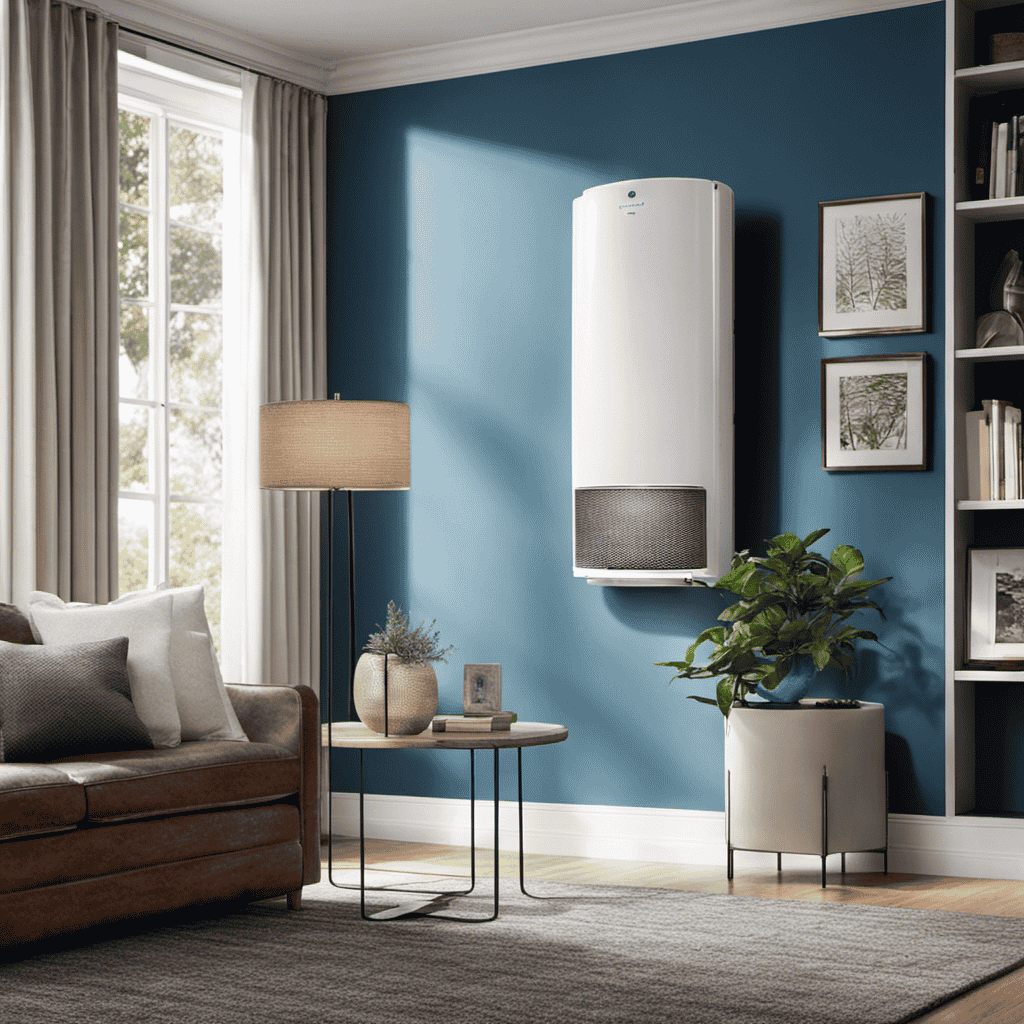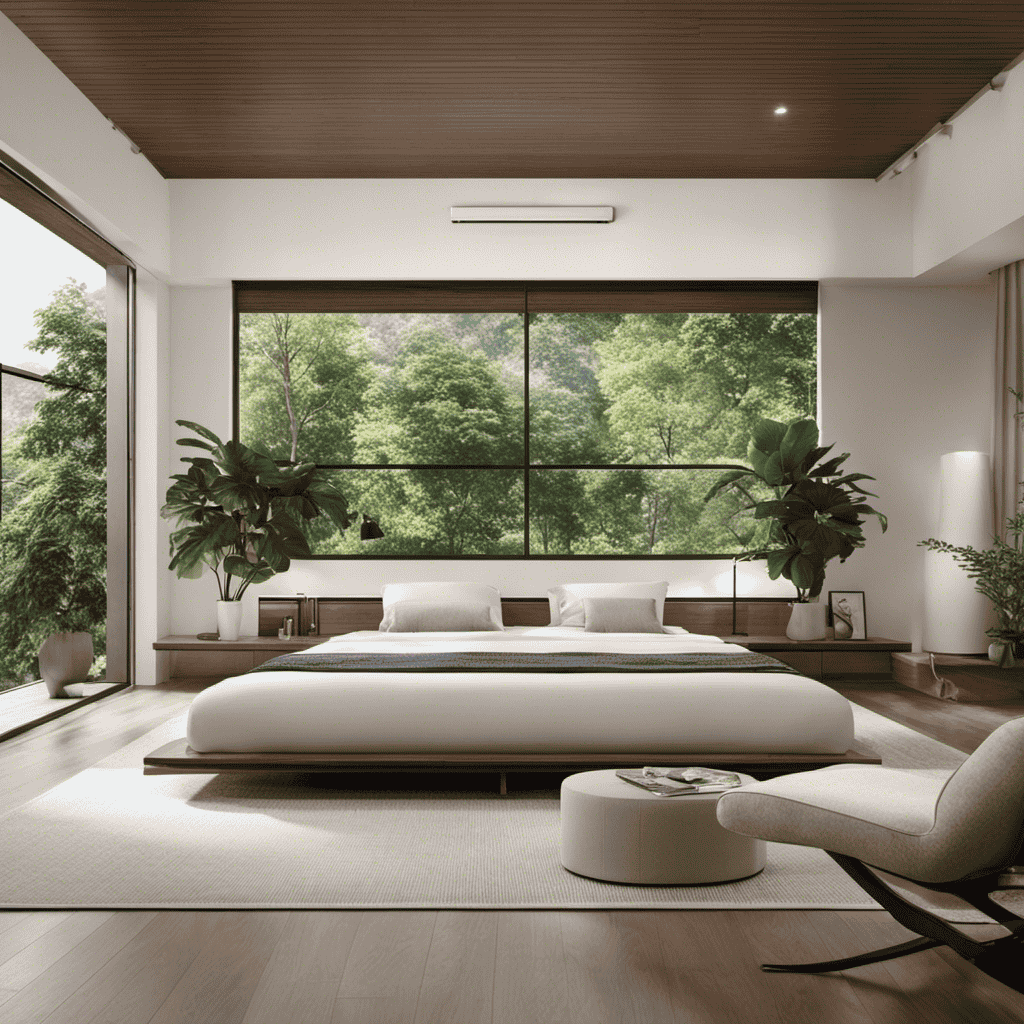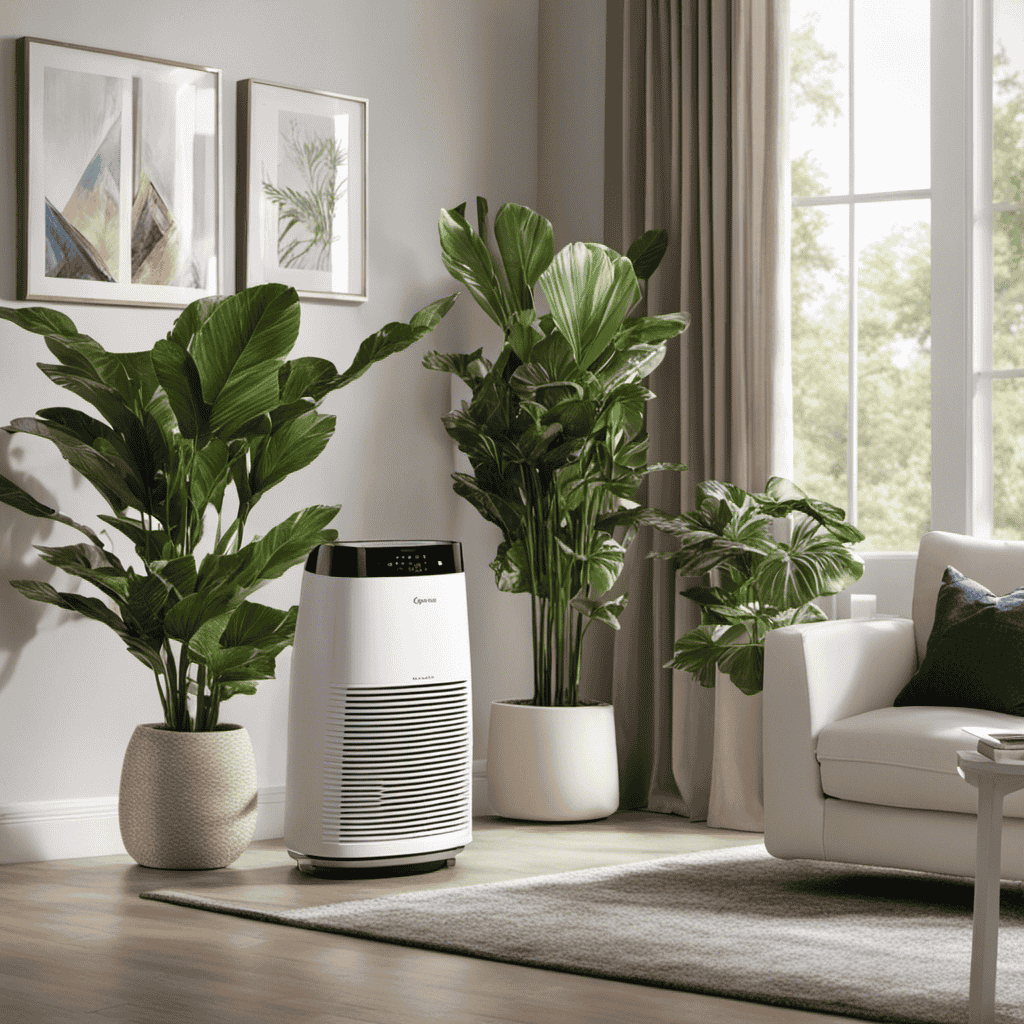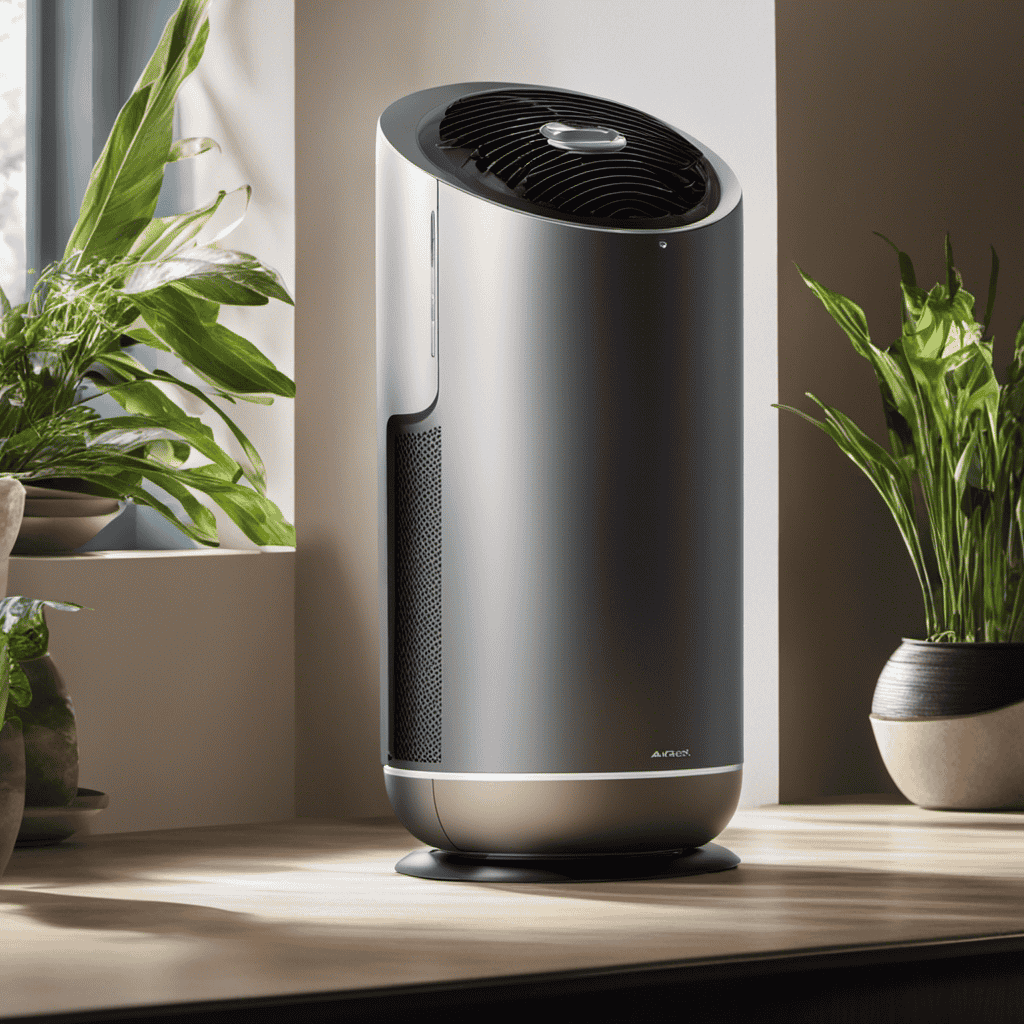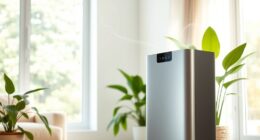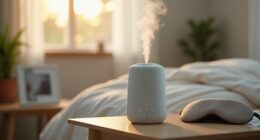I’ve found out that the air inside can be up to five times more contaminated than the air outside, which could negatively affect our health. That’s the reason I’m eager to pass on my insights on the proper use of the Blueair Air Purifier.
In this article, I’ll guide you through unboxing, setting up, and optimizing the performance of your Blueair Air Purifier. With its advanced features and user-friendly interface, you’ll be able to enjoy cleaner, fresher air in no time.
Let’s get started!
Key Takeaways
- Unboxing and setting up the Blueair Air Purifier is straightforward and hassle-free.
- Different models of Blueair Air Purifiers offer unique features and noise levels.
- Proper placement and maintenance of the air purifier ensure optimal performance and clean indoor air.
- Adjusting settings and utilizing additional features like smart home integration and timer function enhance the air purifier’s effectiveness and convenience.
Unboxing the Blueair Air Purifier
First, you’ll want to unbox the Blueair Air Purifier to get started. The unboxing experience with the Blueair Air Purifier is straightforward and hassle-free. Upon opening the box, you will find the air purifier unit, filters, and a user manual. Carefully remove all packaging materials and place the unit on a flat surface.
The next step is the initial setup. Start by removing the plastic wrap from the filters and installing them into the air purifier. Make sure they are securely in place. Then, plug in the unit and turn it on. The Blueair Air Purifier is now ready to purify the air in your space.
Transitioning into the next section about understanding the different models of Blueair Air Purifiers, let’s explore the features and benefits of each model.
Understanding the Different Models of Blueair Air Purifiers
When choosing a Blueair model, you’ll want to consider the different features and sizes available. Blueair offers a range of air purifiers in various colors, allowing you to choose one that matches your personal style and home decor. In terms of comparing Blueair air purifiers to other brands, Blueair stands out for its superior performance and innovative technology. The table below provides an overview of some of the popular Blueair models and their key features:
| Model | Size | Filters | Noise Level |
|---|---|---|---|
| Blueair Classic 480i | Large | HEPASilent Technology | 32 – 52 dB |
| Blueair Blue Pure 211+ | Medium | Particle + Carbon Filter | 31 – 56 dB |
| Blueair Blue Pure 411 | Small | Particle + Carbon Filter | 17 – 46 dB |
| Blueair Blue Pure Mini | Compact | Particle + Carbon Filter | 17 – 46 dB |
With Blueair air purifiers, you can trust that you are getting a high-quality product that effectively removes airborne pollutants and allergens, providing you with clean and fresh air in your home.
Setting up Your Blueair Air Purifier
Once you’ve selected the ideal Blueair model, it’s time to set it up in your home. Setting up your Blueair air purifier is a straightforward process that can be done in a few simple steps:
-
Find a suitable location: Place your air purifier in a central area of the room, away from walls and furniture, to allow for optimal airflow.
-
Plug it in: Connect the power cord to a grounded electrical outlet. Ensure that the power switch is turned off before plugging it in.
-
Turn it on: Once plugged in, switch the power on and adjust the settings according to your preference.
Troubleshooting common issues with your Blueair air purifier:
-
Check the filters: Make sure the filters are properly installed and clean. Replace them if necessary.
-
Clear any obstructions: Ensure that the air intake and outlet are free from any blockages.
-
Contact customer support: If the issue persists, reach out to Blueair’s customer support for further assistance.
Setting up your Blueair air purifier is a simple process that can greatly improve the air quality in your home. By following these steps and troubleshooting common issues, you can enjoy clean and fresh air in no time.
Placing the Blueair Air Purifier in the Optimal Location
To optimize airflow, make sure you find a central location in the room for your Blueair air purifier. Proper placement of the air purifier is essential for maximizing its effectiveness. When selecting a spot, consider the size of the room and the layout of furniture.
Place the purifier at least 1-2 feet away from walls or other objects to allow for proper air circulation. Avoid placing it near windows or doors where outdoor pollutants can easily enter. By positioning the air purifier in a central location, you ensure that the clean air is distributed evenly throughout the room, providing you with the maximum benefits of using an air purifier.
Additionally, proper maintenance of the purifier, such as regularly cleaning or replacing filters, is crucial for optimal performance and longevity.
Powering on and off the Blueair Air Purifier
When it comes to powering on and off the Blueair Air Purifier, there are a few key points to keep in mind.
First, to switch the purifier on, simply locate the power button, usually located on the top or front panel of the device, and press it firmly.
To turn the purifier off, press the power button again until the device shuts down.
It is important to note that properly powering on and off the purifier ensures optimal performance and energy efficiency.
Switching the Purifier on
Before you start using the Blueair air purifier, make sure to switch it on to begin the purification process.
The Blueair air purifier is equipped with an easy-to-use control panel where you can adjust the fan speed according to your preferences. To increase or decrease the fan speed, simply press the fan speed button until you reach your desired setting.
It is recommended to start with a lower fan speed and gradually increase it to achieve optimal air purification.
Additionally, the Blueair air purifier comes with a filter replacement indicator that alerts you when it’s time to replace the filters. To ensure the longevity and effectiveness of the purifier, make sure to follow the filter replacement guidelines provided by Blueair.
Remember to switch off the purifier before replacing the filters to avoid any accidents or damage to the device.
Turning It off
After using it, remember to switch off the purifier to conserve energy and extend its lifespan. Blueair air purifiers come with energy-saving features to help you reduce your carbon footprint and save on electricity bills. Here are some troubleshooting tips if you encounter any power-related issues:
| Problem | Solution |
|---|---|
| Purifier not turning on | Check if the power cord is properly connected and the outlet is functioning. If the issue persists, contact customer support. |
| Purifier turning off randomly | Ensure that the power button is not accidentally pressed. If the problem persists, check for any overheating or dust accumulation on the unit. Clean the filters and contact customer support if needed. |
| Purifier not responding to remote control | Replace the batteries in the remote control and ensure that there are no obstructions between the remote and the purifier. If the problem continues, contact customer support. |
| Purifier making unusual noises | Check if any foreign objects are stuck in the fan or filters. Clean or replace the filters if necessary. If the noise persists, contact customer support. |
Adjusting the Fan Speed on Your Blueair Air Purifier
To adjust the fan speed on your Blueair air purifier, simply press the speed button and select your desired setting. The fan speed control allows you to customize the airflow according to your preference and the air quality in your space.
Here are some key features of the fan speed settings on the Blueair air purifier:
-
Low Speed: This setting provides gentle and quiet purification, perfect for use during sleep or in noise-sensitive environments.
-
Medium Speed: The medium speed setting offers a balanced combination of air purification and noise level, making it suitable for everyday use in most environments.
-
High Speed: When you need maximum purification power, the high-speed setting delivers strong airflow and efficient cleaning performance.
Understanding the Different Filtration Levels of the Blueair Air Purifier
Understanding the different filtration levels of your Blueair air purifier is essential for ensuring the highest quality of air in your space. Blueair air purifiers are equipped with advanced filtration technology that effectively removes airborne pollutants and allergens from the air.
The filtration system consists of multiple layers, each designed to target specific contaminants and improve the overall air quality. The first stage is the pre-filter, which captures larger particles such as dust and pet hair.
Next is the activated carbon filter, which removes odors, gases, and VOCs. The final stage is the HEPA filter, which traps microscopic particles like pollen, mold spores, and bacteria.
Changing the Filters on Your Blueair Air Purifier
When it comes to changing the filters on my Blueair Air Purifier, there are three key points to consider:
-
Filter replacement frequency: Understanding the frequency at which filters need to be replaced is crucial for maintaining the efficiency of the air purifier and ensuring clean air in my home.
-
Proper installation technique: Knowing the proper installation technique is essential to ensure that the filters are correctly placed and functioning optimally.
-
Finding compatible filters: Lastly, finding compatible filters is important to guarantee that the replacement filters are designed to fit my specific Blueair Air Purifier model, providing the best filtration performance.
Filter Replacement Frequency
Remember, you’ll need to regularly replace the filters in your Blueair air purifier to maintain optimal performance. Regular filter maintenance is crucial for ensuring that your air purifier effectively removes pollutants and allergens from your indoor air.
Here are some signs that indicate when it’s time to replace the air purifier filter:
-
Decreased airflow: If you notice that the airflow from your Blueair air purifier has significantly decreased, it may be a sign that the filter is clogged and needs to be replaced.
-
Increased dust and particles: If you start noticing an increase in dust and particles in your home, it could mean that the filter is no longer able to effectively capture and trap these contaminants.
-
Unpleasant odors: If your air purifier starts emitting unpleasant odors, it may be a sign that the filter is saturated and needs to be replaced.
Proper Installation Technique
When it comes to properly installing your Blueair air purifier, there are a few important tips to keep in mind.
One common mistake is not reading the installation instructions thoroughly before starting. It is essential to familiarize yourself with the specific model’s installation requirements to ensure proper functioning.
Additionally, make sure to choose a suitable location for your air purifier, away from obstructions such as furniture or curtains that may impede airflow.
Another common mistake is neglecting to clean the air purifier before installation. Dust and debris can accumulate over time and hinder its performance. Therefore, it is crucial to clean the unit regularly to maintain optimal air purification.
By following these installation tips and avoiding common mistakes, you can ensure that your Blueair air purifier operates effectively and efficiently.
Now that we have covered the proper installation technique, let’s move on to the next section about finding compatible filters.
Finding Compatible Filters
To ensure optimal performance, it’s important to find filters that are compatible with your specific model. When it comes to finding replacement filters for your Blueair air purifier, there are a few key factors to consider:
-
Filter size: Blueair offers filters in different sizes, so it’s crucial to choose the right size for your air purifier. You can find this information in the user manual or on the Blueair website.
-
Filtration efficiency: Blueair filters are known for their high-performance filtration capabilities. Look for filters that are designed to remove a wide range of pollutants, such as dust, pollen, pet dander, and even bacteria and viruses.
-
Filter lifespan: It’s important to consider the lifespan of the filters and how often they need to be replaced. Blueair filters typically last between six months to one year, depending on usage and air quality.
By finding compatible filters that suit your specific needs, you can ensure that your Blueair air purifier continues to effectively clean the air in your home.
Now let’s explore the next section on cleaning and maintaining your Blueair air purifier.
Cleaning and Maintaining Your Blueair Air Purifier
Cleaning and maintaining your Blueair air purifier is essential for optimal performance. Proper cleaning techniques and a regular maintenance schedule will ensure that your air purifier continues to effectively filter indoor air pollutants. Here are some steps to keep your Blueair air purifier in top condition:
-
Cleaning the Filters: Regularly clean or replace the filters according to the manufacturer’s instructions. This will prevent buildup of dust and particles, ensuring efficient filtration.
-
Cleaning the Exterior: Wipe the exterior of the air purifier with a damp cloth and mild detergent to remove any dirt or dust.
-
Maintenance Schedule: Create a maintenance schedule to remind yourself of when to clean or replace the filters. This will help you stay on top of the maintenance tasks and keep your air purifier running smoothly.
By following these cleaning techniques and maintaining a regular schedule, you can ensure that your Blueair air purifier functions optimally and provides you with clean and fresh indoor air.
Now, let’s explore how to use the Blueair air purifier with smart home integration.
Using the Blueair Air Purifier With the Smart Home Integration
To incorporate smart home integration into your routine, simply connect the Blueair air purifier with your existing smart home devices. This feature offers several benefits and allows you to control the air purifier remotely.
Here are some advantages of using smart home integration with your Blueair air purifier:
-
Convenience: With smart home integration, you can control your air purifier from anywhere in your home using your smartphone or voice commands.
-
Energy Efficiency: By remotely monitoring and controlling your air purifier, you can ensure that it is only running when needed, saving energy and reducing your carbon footprint.
-
Customization: Smart home integration allows you to create personalized schedules and settings for your air purifier, ensuring that it runs at optimal times and settings for your specific needs.
Understanding the Indicators and Alerts on Your Blueair Air Purifier
When it comes to understanding the indicators and alerts on your Blueair Air Purifier, there are a few key points to keep in mind.
First, it’s important to know what each indicator means and how to interpret them correctly.
Second, troubleshooting tips for alerts can help you address any issues that may arise with your purifier.
Finally, maximizing the performance of your purifier involves following specific guidelines and maintaining regular maintenance.
Indicator Meanings Explained
The blueair air purifier’s indicator light will tell you if the air quality is good or bad. Understanding the indicator meanings and troubleshooting alerts is crucial for optimizing the performance of your air purifier.
Here are the meanings of the indicator lights:
- Blue Light: Indicates that the air quality is good and the purifier is working properly.
- Red Light: Indicates that the air quality is poor and the purifier is actively removing pollutants.
- Yellow Light: Indicates that the filter needs to be replaced or cleaned.
Troubleshooting alerts:
- Blinking Red Light: Indicates a malfunction or error in the purifier. Refer to the user manual for troubleshooting steps.
- Solid Red Light: Indicates a serious issue that requires immediate attention. Contact customer support for assistance.
Alert Troubleshooting Tips
Understanding the meanings of the indicator lights and troubleshooting alerts on the blueair air purifier is essential for addressing any issues that may arise. The alert notification system is designed to inform users of any potential problems with the purifier and provide guidance on how to resolve them. Below is a helpful troubleshooting guide that explains the various alerts and their meanings:
| Alert | Description | Action |
|---|---|---|
| Red Light | Indicates a filter replacement is needed | Replace the filter as per the manufacturer’s instructions |
| Yellow Light | Indicates a decrease in air quality | Check for any obstructions or clean the air intake |
| Blinking Light | Indicates a sensor malfunction | Contact customer support for further assistance |
| No Light | Indicates normal operation | No action required |
Maximizing Purifier Performance
To get the most out of your Blueair purifier, it’s important to regularly clean the filters. Clean filters are essential for maximizing filter efficiency and improving air quality in your home or office. Here are some tips to help you optimize your purifier’s performance:
-
Clean or replace filters every 6 months: Over time, filters accumulate dust, allergens, and other pollutants, reducing their effectiveness. Regular cleaning or replacement ensures that your purifier can continue to capture and remove airborne particles efficiently.
-
Vacuum the pre-filter: The pre-filter is the first line of defense against larger particles. Vacuuming it regularly helps maintain its effectiveness and prolongs the lifespan of the main filter.
-
Check the carbon filter: If your Blueair purifier has a carbon filter, make sure to replace it according to the manufacturer’s instructions. Carbon filters help remove odors and volatile organic compounds (VOCs), but they can become saturated over time.
Using the Timer Function on Your Blueair Air Purifier
Using the timer function on my Blueair air purifier is a convenient way to automatically control the operating hours. This feature allows me to program the purifier to turn on and off at specific times, ensuring optimal air quality without the need for constant monitoring.
To program the timer, I simply press the timer button on the control panel and use the arrow buttons to set the desired start and end times.
Additionally, my Blueair air purifier also has a sleep mode, which automatically reduces the fan speed and noise level during nighttime hours, providing a peaceful and undisturbed sleep environment. I can easily activate the sleep mode by pressing the dedicated sleep button on the control panel.
Overall, these features make it effortless to customize the operating schedule of my Blueair air purifier to suit my specific needs.
Adjusting the Air Quality Settings on Your Blueair Air Purifier
Adjusting the air quality settings on your Blueair air purifier is a simple process that allows you to customize the purification level according to your preferences. By making these adjustments, you can improve the air quality in your home or office and create a healthier environment for yourself and your loved ones.
Here are some key points to consider when adjusting the settings:
-
Filter Replacement: Regularly check and replace the filters in your air purifier to ensure optimal performance and clean air circulation.
-
Fan Speed: Increase the fan speed for faster air purification in highly polluted areas, or decrease it for quieter operation during the night.
-
Auto Mode: Enable the auto mode feature to allow the purifier to adjust its settings automatically based on the air quality readings.
Optimizing the Performance of Your Blueair Air Purifier
By optimizing the performance of your Blueair purifier, you can ensure cleaner and fresher air in your surroundings. One of the key aspects of maintaining the optimal performance of your air purifier is regular filter maintenance. Cleaning or replacing the filters as recommended by the manufacturer is crucial to ensure effective air purification. Neglecting filter maintenance can result in reduced airflow and compromised air quality. To help you understand the importance of filter maintenance, here is a table summarizing the benefits:
| Filter Maintenance Benefits |
|---|
| Removes dust and allergens |
| Eliminates odors |
| Reduces pet dander |
| Improves indoor air quality |
| Extends the life of the purifier |
Regularly cleaning or replacing the filters will keep your Blueair air purifier running efficiently and effectively, providing you with cleaner and fresher air to breathe.
Troubleshooting Common Issues With Your Blueair Air Purifier
When it comes to troubleshooting common issues with your Blueair Air Purifier, two key areas to focus on are noisy fan solutions and filter replacement tips.
If you’re experiencing a noisy fan, there are several steps you can take to address the problem, such as cleaning the fan blades and ensuring the unit is placed on a stable surface.
Additionally, understanding the proper filter replacement schedule and technique is crucial for maintaining optimal performance and air quality.
Noisy Fan Solutions
To reduce the noise from the fan, you can try placing the Blueair air purifier on a soft surface like a rug or carpet. This will help absorb some of the vibrations and reduce the overall noise level.
Additionally, you can try the following tips for quieter operation:
- Clean the fan blades regularly to remove any dust or debris that may be causing the noise.
- Check if the air purifier is placed on a stable surface. A wobbly or uneven surface can cause vibrations and increase noise.
- Adjust the fan speed settings. Lowering the fan speed can help reduce noise, although it may also decrease the air purifying efficiency.
Filter Replacement Tips
Regularly replacing the filters in your air purifier is essential for maintaining optimal performance and ensuring clean, fresh air in your home. Filter maintenance plays a crucial role in prolonging the filter lifespan and maximizing the effectiveness of your air purifier.
To properly care for your filters, it is recommended to follow the manufacturer’s guidelines for replacement intervals. Typically, filters should be replaced every six to twelve months, depending on the air quality and usage. Regularly vacuuming or washing the pre-filter can also help extend the lifespan of the main filter.
Additionally, it is important to check for any signs of damage or clogging in the filters and replace them immediately if needed. By consistently maintaining your air purifier’s filters, you can ensure that it continues to provide you with clean and healthy air for years to come.
Frequently Asked Questions
Can I Use My Blueair Air Purifier in a Small Room?
Yes, you can use the Blueair air purifier in a small room. It offers several benefits such as removing airborne pollutants, improving indoor air quality, and reducing allergy symptoms.
How Often Do I Need to Change the Filters on My Blueair Air Purifier?
I change the filters on my Blueair air purifier every six months. To clean the filters, I follow the manufacturer’s instructions. Replacement filters can be purchased online or at authorized retailers.
Can I Control My Blueair Air Purifier Remotely Through a Smartphone App?
Yes, you can control your Blueair air purifier remotely through a smartphone app. This feature allows you to adjust settings, monitor air quality, and schedule cleaning cycles for optimal performance.
What Should I Do if the Indicator Light on My Blueair Air Purifier Turns Red?
If my Blueair air purifier’s indicator light turns red, I would first check the user manual for troubleshooting tips. If that doesn’t solve the issue, I would consider cleaning or replacing the filters to ensure proper functioning.
How Do I Optimize the Performance of My Blueair Air Purifier for Better Air Quality?
To improve performance and maintain air quality with my Blueair air purifier, I follow a thorough maintenance routine. This includes regular filter changes, cleaning the unit, and keeping it in a well-ventilated area.
Conclusion
In conclusion, using the Blueair Air Purifier has greatly improved the air quality in my home.
It was easy to unbox and set up, and the different models allowed me to choose the perfect one for my needs.
By placing the purifier in the optimal location and adjusting the air quality settings, I was able to optimize its performance.
The timer function was convenient, and troubleshooting common issues was a breeze.
Overall, the Blueair Air Purifier has been a game-changer, and my home now feels like a breath of fresh air.

